Incoming freshmen have been excluded from these previews, as we'd like to wait and see what they have to offer on the NCAA level before we come to any long-term conclusions.
-Top 20 NBA Prospects in the Big Ten
-Top 20 NBA Prospects in the ACC
-Top 11 NBA Prospects in the Big XII
-Top NBA Draft Prospects in the Pac-12, Part One, #1-5
(#1) Andre Roberson
(#2) Joshua Smith
(#3) C.J. Wilcox
(#4) Devon Collier
(#5) Allen Crabbe
#6, Eric Moreland, 6-10, Redshirt Sophomore, PF/C, Oregon State
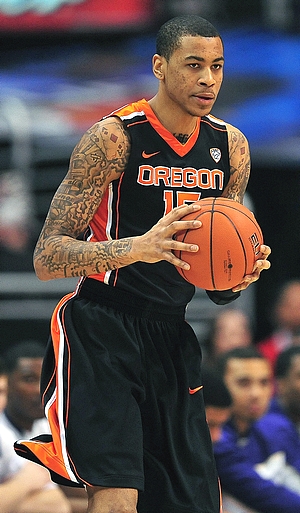
Jonathan Givony
Deemed a marginal prospect out of high school, Eric Moreland didn't garner too many accolades early on in his career, signing with UTEP initially after a year of prep school. Once the coach who signed him, Tony Barbee, left for Auburn, Moreland was told his services would no longer be needed by the new coaching staff, headed by Tim Floyd. He was forced him to transfer to Oregon State, but was given a waiver by the NCAA and thus not required to sit out the year.
One man's trash is another man's treasure, and after only playing four games and eventually redshirting due to a shoulder injury, Moreland emerged as one of the most intriguing young big men prospects in the Pac-12 this past season.
Moreland didn't play a huge role for the Beavers, only ranking 7th in both minutes played and possessions used, but was nevertheless able to lead the Pac-12 in blocked shots and rebounds per-40 minutes pace adjusted.
Moreland's appeal as a long-term prospect is readily understandable on first glance, as he possesses rare physical attributes standing 6-10, with a pterodactyl (reportedly 7-4) wingspan and excellent mobility. He runs the floor well, is extremely fluid and agile, and is capable of playing above the rim with ease.
Not a prolific scorer by any stretch, averaging just 5 points per game last season, Moreland lives off whatever scraps his teammates are able to create for him around the basket as well as whatever he can find by running the floor and crashing the offensive glass. He doesn't have the bulk or footwork to do any real damage with his back to the basket, and can't really step away from the paint and threaten opposing defenses with his jump-shot.
Nevertheless, Moreland shows intriguing glimpses of potential in other areas. He's capable of finishing with either hand around the basket, sometimes from extremely difficult angles due to the sheer extension he gets with his freakish wingspan. He also has the ability to put the ball on the floor and attack unbalanced defenses from the perimeter, showing much better ball-handling ability than you'd expect from your typical skinny and raw 6-10 big mana testament to his upbringing as a point guard until hitting a late growth spurt. His athleticism and aggressiveness allows him to draw fouls at a very high rate, as he indeed led the entire Pac-12 in free throw attempts per possession last season. Unfortunately he wasn't always able to convert these opportunities, as he only made 49.5% of his free throws, again hinting at how unpolished his jump-shot is as the moment.
Clearly still in an early stage of his development, Moreland doesn't seem to quite know the limitations of his game just yet, as he can be very turnover prone at times, especially with his wild forays to the rim. His basketball IQ is not bad, as he'll often show by making some very creative passes, but he just doesn't have much experience at the moment. With Oregon State's most talented and creative guard, Jared Cunningham, off to the NBA, it will be interesting to see how his role develops this year.
Defensively, Moreland shows tremendous potential with his rare combination of length and mobility. He is a bit inconsistent on this end of the floor, though, as was his entire Oregon State last year, a big reason they finished 7-11 in a very weak Pac-12 despite possessing a decent amount of talent on their roster.
Moreland's fundamentals on this end of the floor are fairly average, as he tends to lose his focus easily, and doesn't always put the work in early in possessions. Older, more experienced players can take advantage of his lack of experience and get him to bite on pump-fakes or gamble for a steal on the perimeter. To his credit, Moreland is often talented enough to still recover and make a play at the rim with his tremendous length and mobility. This helps explain his propensity for accumulating steals and blocks, as he possesses terrific timing for getting his hands on loose balls, and indeed ranked as one of the sixth best per-minute rebounder and shot-blocker in the country amongst freshmen last season. This leaves a lot of room for optimism about how he might develop on this end of the floor down the road.
Showing the size of a power forward but the offensive skill-level of a center, Moreland is a bit stuck between positions. He has a tough time keeping stronger big men out of the paint, giving up deep post-position early in possessions, and not having the bulk to avoid getting backed down in one on one situations. He will need to improve his toughness and lower body strength substantially to defend NBA big men effectively. With his narrow frame, the question is, how much weight can he put on? This will likely play a major role in how he's viewed as a pro prospect, especially since he's older than most of the players in his class, turning 21 at the end of December.
Players with Moreland's physical attributes and prowess as a rebounder and shot-blocker are highly coveted at the next level, so many scouts will likely be watching with intrigue to see how he develops moving forward. If he can continue to produce at the same rate in a larger role this season, he is likely to draw plenty of attention to himself.
#7, Brock Motum, 6'9, Senior, Power Forward, Washington State
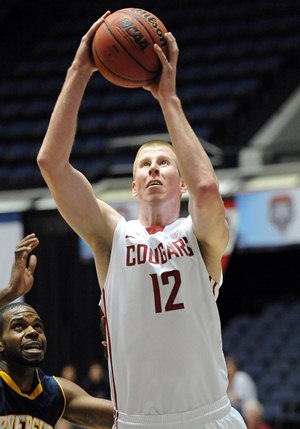
Derek Bodner
After losing Klay Thompson to the NBA draft, the Washington State Cougars needed somebody to step up on the offensive side of the court. This need became even more pressing of a need when Faisal Aden suffered a torn ACL in late January.
Motum had largely been a role player during his first two years at Washington State, playing only 19 minutes per game as a sophomore and providing an efficient 7.6 points per game off the bench, scoring a large majority of his points off of cuts and spot-up opportunities.
That all changed for Motum this season, and he responded perhaps as well as anybody could have reasonably expected him to. Motum upped his per-game scoring average from 7.6 to 18, his per-40 minute pace adjusted average from 15.2 to 23.7, while suffering hardly any drop in efficiency, as his true shooting percentage dropped only slightly from 64% to 63%. After Aden went down with an injury late in the season, Motum stepped up even further, averaging 23 points per game over the his final 13 games before his season was ended by an ankle injury, proving to be one of the most prolific scoring big men in the country. Motum doesn't look the part of your typical NBA power forward, running a bit awkwardly and not showing much quickness or explosiveness, but his scoring instincts are extremely impressive, and will give him a chance to make a significant living in professional basketball, be it in Europe or the NBA.
Cuts and spot-up opportunities still represent a good portion of Motum's offense, as he and fellow senior Reggie Moore have developed good two-man game between them. He gets a far higher percentage of his half-court game in post-up situations, now at 16% of his total offense, which is up from 8.7% his sophomore year, according to Synergy Sports Technology. The lefty likes to come across the lane and shoot a hook over his right shoulder, which he has very good touch on and does a good job getting off. He is still a little weak with his off hand, and can become a little bit predictable because of that. While not an explosive leaper, Motum has great body control, excellent touch around the basket and does a good job of getting his shot off despite playing largely below the rim.
Motum's perimeter skills have also taken a step forward this past season, extending his range out to collegiate three point range and improving off the dribble. Making 40% of his 3-point attempts on the season, Motum's shot looks more consistent, and while a little bit long to develop he has a consistent, repeatable motion with good follow through. As a ball-handler, he once again largely prefers going to his left, where he has a deceptive first step and nice touch when going towards the basket. He doesn't show very many counter moves, and his right hand isn't useful for much more than simple straight line drives, but Motum does a good job of using the threat of his jump shot and ball fakes to get his way into the paint with regularity, drawing fouls at a very nice clip.
One area where Motum has struggled with his transition to a high usage offensive player has been in the turnover department, where his 3.8 turnovers per 40 minutes is among the top for power forwards in our database. This should improve as he becomes less of a focal point offensively, as he's simply not all that comfortable as a passer and his recognition leaves a lot to be desired in this facet of the game.
Perhaps the biggest improvement in his game has been on the defensive glass. At 2.8 and 3.6 defensive rebounds per 40 minutes pace adjusted during his first two seasons at Washington State, Motum consistently rated towards the bottom of our database for power forwards. While the 6.0 per 40 pace adjusted isn't particularly outstanding, it's far closer towards respectability than he has previously been able to haul in.
The defensive side of the ball still represents the biggest problem in trying to project him to the next level. While Motum appears to have added some strength to his frame, he still struggles to hold position in the post, and overall does a poor job of contesting shots. He also struggles to change direction, which could present problems defending the pick and roll at the next level. Motum tends to show hard on the ball handler, and struggles to rotate back to his man. He doesn't present much in the form of weak side help defense, not being much of a shot blocker and being slow on rotations.
Brock Motum performed about as well as anybody could have reasonably hoped this season, improving in many areas of his game as he became the top scoring option on an undermanned Washington State team. Although Motum still has flaws in his game that he'll have to work to correct, his big improvement between his sophomore and junior seasons has placed him on the map as a prospect. While Motum's athletic deficiencies may make it difficult for him to improve his rebounding and defensive ability as much as some scouts may hope, his offensive versatility as a 6-9 power forward who can put the ball in the net efficiently from anywhere on the floor will certainly draw him some interest over the course of his senior year. It's difficult to find players his size who can score as naturally as he can, which gives him at least a fighting chance to prove he won't be a liability in other areas.
#8, Chasson Randle, 6'1, Sophomore, PG/SG, Stanford
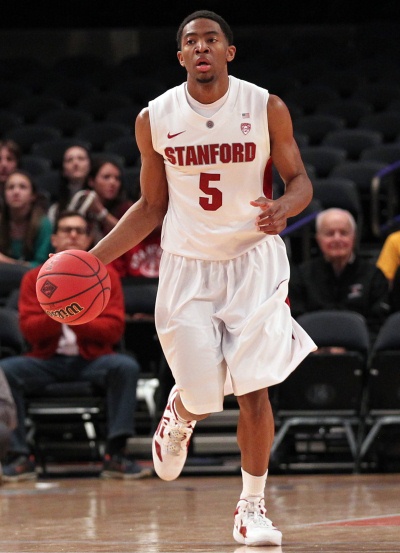
Matt Williams
The second leading freshman scorer in the Pac-12 last season at 13.8 points per-game, Chasson Randle had an immediate impact for the Cardinal. A consensus top-70 recruit, Randle played a key role in Stanford's 26-11 finish which culminated in an NIT Championship. Emerging as his team's top offensive threat, he put together a number of very impressive performances, including a 30-point outburst against Arizona State.
A 6'1 combo guard with a lanky 180-pound frame, and good, but not great, athleticism, Randle would not be a standout physical specimen by NBA standards, though he possesses solid speed and quickness for the college game. Considering he played mostly off the ball as a two-guard last season, the Illinois native would be considered extremely undersized for his position at the next level. Randle was not an unwilling passer, and with three years left to develop, still has plenty of time to progress as a playmaker.
Randle's ability to become a better point guard would be a big boost to his long-term prospects as he's already shown plenty of promise as a perimeter scorer. One of the best 3-point shooters in the freshman class Randle proved to be an extremely dangerous spot-up threat last season, connecting at a 43%-clip from beyond the arc. Shooting the ball with a picturesque, high release point, the young guard showed tremendous range and confidence.
That confidence was evident in other aspects of his game as well at times, as Randle showed the ability to hit deep pull-up jump shots off of one or two dribbles in bunches. Lacking a tremendously explosive first step, Randle isn't going consistently to blow by anyone off the dribble, he does, however, show some amount of promise creating his own shot on the pick and roll and using the threat of his jump shot and solid ball-handling ability to freeze his defender and create separation from the midrange.
A limited finisher, Randle made just 47% of his shots at the rim and just 27% of his floaters according to Synergy Sports Technology. He may never be the type of player who can create high-percentage shots for himself in the paint consistently, as he lacks great explosiveness and leaping ability, but he'd be well served to polish his floater or be more aggressive trying to get to the line.
Defensively, Randle is competitive, makes the appropriate decisions within Stanford's team concepts, and shows solid lateral quickness. His lack of strength, size, and experience hurt him at times, especially when defending stronger, quicker guards, but he has the right mentality to be a very good overall defender at the college level in time.
Chasson Randle may not seem to have the highest ceiling, but he has a very good basketball IQ and the makings of an extremely prolific perimeter scorer at the college level. Only a sophomore, now is not the time to draw any definitive long-term conclusions about the 19 year old guard. Regardless, Randle will be one of the more intriguing players in the Pac-12 this season, and it shouldn't be long until he ranks among the conference's very best scorers.
#9, Mark Lyons, 6'1, Senior, Point Guard, Arizona
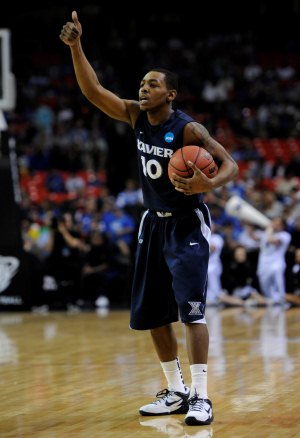
Matt Williams
A transfer from Xavier immediately eligible to play at Arizona this season, Mark Lyons has gone from forming one of the most explosive offensive backcourts in college basketball with Tu Holloway to leading an Arizona squad adding a surplus of talented underclassmen that desperately needs a leader at the point guard position. Stepping into a role tailor made to what he needs to show to improve his draft stock, Lyons has a golden opportunity to lead his team deep into the NCAA Tournament and improve his NBA Draft stock this season.
Leaving the Xavier program after a tumultuous but mostly successful season, Lyons immediately fills the void at the point guard position for the Wildcats. Standing 6'1 with a 6'4 wingspan and a 190-pound frame, the 5th year senior is a scoring point guard who showed the ability handle defensive pressure, run the pick and roll, and break down defenders one-on-one splitting point guard duties for stretches with Tu Holloway as a junior.
The less natural passer of the two, Lyons will be looked upon to set the table for Arizona's extremely gifted group of incoming big men, including the likes of Kaleb Tarczewski, Grant Jarrett, and Brandon Ashley. Averaging just 3.4 assists per-40 minutes pace adjusted last season while spending plenty of time off the ball, Lyons has the quickness to turn the corner, NBA-level speed, and the ball-handling ability to distort defenses, the question is: can he find the proper balance between scoring and passing to help the Wildcats reach their potential this season?
At Xavier, Lyons showed some potential as a distributor, but was mainly looking for his own offense, even when Holloway was off the floor. Lyons certainly has the athleticism to create, but the onus will be on him to take fewer tough shots in the paint, make the easy plays, and use his penetration, especially on the pick and roll, to make his teammates better.
Lyon's scoring should also come in handy this season and will remain a big part of his value proposition at the next level regardless of how he fares running his new team. An extremely aggressive penetrator, the Brewster Academy product's shot attempts are distributed fairly evenly from the inside and outside. He uses hesitation moves and quick bursts of speed to get an edge and get in the paint, but makes less than stellar decisions at the point of attack at times. Getting tunnel vision to the rim and sometimes driving right into the teeth of the defense or getting stripped before getting a chance to elevate, Lyons shot an unspectacular 45.9% at the rim last season according to Synergy Sports Technology.
Away from the basket, Lyons was relatively more efficient. He's a good set shooter, knocking down 41% of his catch and shoot jump shots, and is also a threat pulling-up off the dribble. Making a third of his jump shots off the dribble, Lyons was ambitious with his shot selection at times last year. If he can pick and choose his spots more consistently, he can improve his efficiency as a scorer this season in his new role.
Defensively, Lyons is active with his hands and proves to be a good rebounder for his position, but does not always make the most of his tools. When he gets down in a stance and commits himself on the defensive end, he can be a pest, but he looks lackadaisical at times. A bit part of Lyons' leadership ability will become clear in how he sets the tone for his team defensively this season.
Mark Lyons gets to redefine himself as a player in a situation that should align exceptionally with what he needs to show NBA scouts to improve his stock this season. If he can improve as a distributor, make an impact defensively, and shows leadership potential off the floor, he's going to help Arizona win a lot of games and would surely climb our senior rankings.
#10, Travis Wear, 6-9, Junior, Power Forward, UCLA
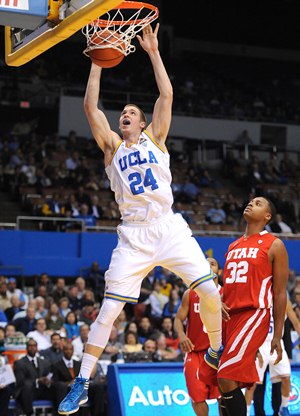
Jonathan Givony
A McDonald's All-American in high school who played a fairly marginal role at North Carolina as a freshman, Travis Wear decided to transfer to UCLA together with his twin brother David at the end of the 2009/2010 season, and saw his first real NCAA action in 2011-2012 as a redshirt sophomore.
Coming off a solid season, Wear is now likely to see significant playing time on a UCLA squad that many have extremely high expectations from, giving him an opportunity to put himself on the map as a role-player who can do a bit of everything on a successful team.
Not particularly impressive from a physical standpoint, Wear has solid size for a power forward at 6-9, but is just an average athlete. He doesn't run the floor incredibly well, nor is he overwhelmingly quick or explosive.
Wear gets most of his points within the flow of the offense, not possessing any one consistent means of scoring that his team can count on. He shoots a high percentage from the floor, makes the extra pass, and doesn't turn the ball over very often, clearly understanding the role he plays and his limitations.
Wear is a fundamentally sound player who moves off ball effectively in UCLA's slow-paced motion offense, allowing him to find seams in which he can get his shot off. He has a bit of a post game he can utilize against similarly sized players, is a very good offensive rebounder, and can create a little offense in a straight line taking his man off the dribble from the perimeter. Considering his athletic limitations, it's unlikely that these parts of his game will be as effective against higher level competition, making it imperative that he improves his jump-shot as his career moves on.
Wear only attempted a handful of 3-pointers last season, even if his mechanics and touch indicate that this could very well become a more dangerous part of his arsenal as his career progresses. Considering the role he'll be asked to play in the NBA, this will be an important part of his evaluation, as he would surely be asked to be a reliable set-shooter and floor spacer to not be an offensive liability.
Defensively, Wear shows good fundamentals and timing and a very high activity level, giving an excellent effort on pretty much every possession he plays. Where he runs into trouble at times is matching up with quicker big men who are capable of beating him off the dribble, or very strong and physical opponents who can back him down inside the post. His lateral quickness is just average, and he doesn't compensate for that with great size, length or strength. Scouts will want to see how he fares going up against the more highly touted power forwards on UCLA's schedule, as there are some question marks about how this part of his game might translate to the NBA.
Another area of concern revolves around Wear's rebounding ability. He pulled down just 4.8 defensive rebounds per-40 minutes pace adjusted last season, which ranked as one the worst rates in our database amongst collegiate power forwards. His lack of strength, explosiveness and at times toughness hurts him here, which is something he'll have to continue to work on moving forward.
Despite turning 22 recently, Wear still has two years of NCAA eligibility remaining. With the spotlight on UCLA likely to increase substantially, Wear has a chance to prove that he is capable of carving out a niche for himself in the NBA, particularly if he's able to expand his range and show he can consistently make an open jump-shot, as well as prove that he won't be a liability defensively and as a rebounder at his position.













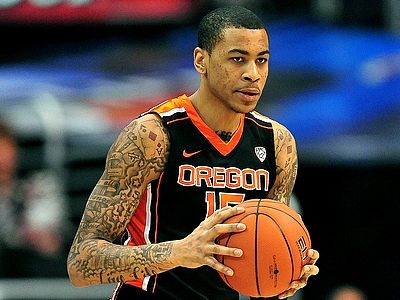

























Comments